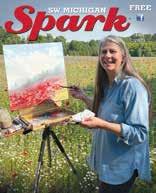
Lisa brings joy through her artwork! ~ Pg. 10


Lisa brings joy through her artwork! ~ Pg. 10



Larry Mann, DO
Q: My child needs a sports physical. What do I need to know?
A: A well-child exam may be a better choice for your child. A wellchild exam is more than a sports physical. It checks your child’s overall health, growth and any past injuries or health concerns. It’s the best way to stay on track with their overall health. Both a wellness exam and a sports physical can identify health problems that could get worse during sports like breathing or respiratory issues. If someone had an injury before, like a concussion, these checkups can help decide if they are okay to play again.
Bronson Family Medicine
bronsonhealth.com/sportsphysical

Justin Reynolds Manager
Q: I hear that Sherriff Goslin Roofing uses their own unique shingle. Can you tell me more about this shingle?
A: The Art Loc shingle is SherriffGoslin’s original patented shingle. It can be used as a re-roofing shingle over another layer of existing shingles, or as a primary shingle over roof sheathing. It assures a smooth, windproof and watertight job. The Art Loc shingle provides a unique appearance and lends character with distinction to any home.
Today’s Art Loc shingle has been modified to include an ingredient known as an SBS (Styrene-ButadieneStyrene) polymer, which is used to alter the properties of asphalt, making the asphalt tougher and more flexible. This polymer dramatically slows down the aging process of the asphalt, providing superior waterproofing, low temperature flexibility, impact resistance, high wind endurance and extended life expectancy.
Call us at (269) 342-0153 or visit us at worryfreeroof. com today to learn more.
Sherriff-Goslin Roofing Co.
Since 1906
342-0153 800-950-1906
Member Home Builders Association of Greater Kalamazoo

Chuck Henrich President & Owner
Q: What should I know before I sign up for Medicare for the first time?
A: Initial Enrollment Period: You have a 7 month window to sign up for Medicare (3 months before your 65th birthday, the month of your birthday, and it ends 3 months after your birthday). If you miss this window, a permanent penalty may occur.
Understanding the Different Parts of Medicare: Part A (hospital) Part B (medical insurance) Part D (prescription coverage) Part C (Advantage plans)
Mandatory Enrollment? If your employer has fewer than 20 employees, you may be required to enroll in Medicare when you turn 65. 20 or more employees, you can generally delay enrollment if you have health benefits provided by your employer.
Contact us to help you understand all of your Medicare options.

A: Located on the second floor above Sawall Health Foods , Café 36 uses natural and organic ingredients in preparing flavorful and exotic selections like Blackened Salmon with Blistered Tomato Rice, Asparagus, and Bleu Crea and Pork Secreto with Chimichurri rice, grilled fennel and charred lemon! There are wonderful pasta dishes including: Bolognese, Cavatelli and creative pizzas such as the Bambini, Margherita, Crudo and Vegano. Organic salads, with produce from local farmers, include Kale Caesar and Spinach & Arugula. There are 20 wines, organic craft beers and hand-crafted cocktails that compliment any meal. After dinner, delicious desserts include Amorino Gelato and Sorbetto, Eton Mess -- English whipped double cream, house-made Meringue, red berry Chambord coulis, Amorino Gelato, and Seasonal New York Cheesecake. Café 36 is very popular with Sawall customers looking for a healthy place to eat. Check out the new fall Café 36 menu!
Café ’36
Wed—Sat 5-9pm 501-3399
Sawall Health Foods
Oakwood Plaza • 2965 Oakland Dr. at Whites Rd. • 343-3619 • www.sawallhf.com


Q: How much time should I allow for an appointment with a senior living community Sales Counselor?
A: Allowing up to 90 minutes for a personized appointment will give you a great start in understanding what options work best for your health age and finances as well as timing your move.
Friendship Village
“Where Connections Matter” 1400 North Drake, Kalamazoo 269-381-0560 www.friendshipvillagemi.com

Kim Powers, Owner, Licensed Professional Counselor
Q: Why would I set a boundary in my relationship?
A: Boundary setting creates a framework for how you can simultaneously love others and love yourself in a healthy way while communicating your wants and needs, without compromising yourself. Without safety and parameters, the relationship may become dysfunctional, leading to bitterness and resentment, even abuse. Boundaries can enhance the quality of a relationship, end a toxic relationship, or create better balance and improve the dynamics, helping you to honor yourself and your worth.
The first recorded mention of a wedding, took place in Mesopotamia in 2350 BC.
Things have certainly changed since then.
When growing up, most of the weddings I attended were in churches, with a small reception afterwards at the church or a local banquet hall.
Weddings continue to evolve and get more extravagant.
I just read that Amazon founder Jeff Bezos is getting married in Venice and trying to take over half the city. The locals are not happy in this already very busy city.
Jackie and I recently attended two weddings.


In late May, Jackie’s nephew was married on a large flat rock on a mountaintop in Fallbrook, California, about an hour north of San Diego. The several mile drive up steep, winding mountainous roads was not for the faint of heart. I was very glad we did not have to do it in the dark. The wedding ceremony and view were wonderful.
In June, my son Sam and his bride, Becca, were married in Asheville, North Carolina near where they live. The recent Hurricane Helene with its devastation and floods, made finding locations, extra challenging.
The wedding ceremony and reception were held at the very large Highland Brewing Company. The ceremony itself was outdoors on the roof. They


dodged the rain, which seems to come off the mountains daily, but dealt with the blazing sun.
Luckily it was not a long ceremony as the wedding party struggled in their tuxedos and long dresses. Sam’s dog Winnie was the ring bearer and my daughter Lauren was the dog handler and had her hands full until she found Winnie a shady spot under a bench.
The reception was luckily indoors with plenty of air conditioning.
Both weddings involved most attendees traveling long distances. It was fun meeting new people and asking what state they were from and how they got there. Most folks flew, but some drove, some pulled trailers, some brought dogs and some brought young kids.
Many, including us, found great local attractions around the several days of wedding events including: beaches in San Diego and The Biltmore and downtown Arts District in Asheville.
Who knows what weddings will be like in the future.
With the way things are advancing, soon, there may





Lee A. Dean screendoor @sbcglobal.net
Every family has physical items of great value that are passed down from generation to generation. A particular favorite of mine is a grainy black and white photo of four Union soldiers taken during the Civil War atop Lookout Mountain in Chattanooga, Tennessee. One of those soldiers is my great-great grandfather. There is another category of valuable items that remain in families – those sayings that leave an imprint on our hearts. When we’re little, our folks said them to us. Then, years later, we find ourselves using the same phrases our own kids.
My father had a great collection of these little gems, and I suspect he got a lot of them from his grandfather.
When my siblings and I thought our next meal was slow in arriving, we would plead, “I’m hungry!” Dad would stop our whining with, “You’re hungry? I’m Gordon. Nice to meet you.” Any question including the word “when” would be met with, “Next week at 2 o’clock.”
In past times, televised sports did not include any statistical information. When I asked Dad what the score of a game
was, he’d say, “14 to 4. Can’t you read the scoreboard?”
Family members had a variety of ways to express displeasure about a targeted individual’s perceived lack of intelligence. Grandpa Hartwell would accuse someone of being “dumber than a mud fence.” Someone else would be “dumber than a box of hammers” or simply be labeled “a ninnyhammer.”
Another set of barbs were a bit more subtle. If a person’s common sense lagged their academic achievement, Grandma Den would call that poor soul “an educated fool.” Dad would accuse a braggart of being “as full of crap as a Christmas goose” or of lacking “the common sense God gave a goose.” I wonder what they had against geese.
I have had to adapt some of Dad’s sayings to fit more contemporary sensibilities. Thus, his “snow arse deep to a tall Indian” has been changed to “snow arse deep to an NBA center.”
My mother didn’t have pithy original sayings so much as certain phrases intended to give direction. These phrases were all variations of “stop doing that!” See if any of these sound familiar.
-- Don’t jump up and down in the kitchen! This was said any time something was in the oven that contained yeast

and that needed to rise.
-- Don’t slam the door! This included the front door, the back door, the barn door, and the refrigerator door.
-- Don’t talk to me while I’m knitting! This is a process that involves counting rows of thread. Occasionally, we would try to disrupt her concentration but knew when to stop. A knitting needle inserted in the wrong place can do grievous damage.
-- Don’t tell y our brother to shut up! This seems quaint in the current era of the F-word, but this phrase was strictly taboo in our house.
-- Quit your squalling! “Squalling” was a much stronger synonym for “crying” than “whimpering.” Related to this was…
-- Quit crying and I’ll give you something to cry about! As an adult, I never understood the logic of this. As a kid, I understood it perfectly.
-- Don’t make so much noise! This put a quick end to my desire to play drums in the school band. It was also the framework of my favorite Mom statement.
When my sister and family came for a visit, Mom and my nieces would be in the kitchen making dinner while the adults would hold court in the living room. The subject often turned to politics. My sister Pam was a rock-ribbed
Republican and Dad was a New Deal Democrat to his very core. Their dialogue could get heated and very loud. My brother-in-law and I were relegated to the role of spectators.
Mom usually could ignore the clamor. But one fateful day, the arguing adults had gotten on her last nerve. She poked her head into the living room and asked everybody to keep the noise down. This had no effect. A few minutes later, we heard a simple “Hey!” from the kitchen. The combatants kept shouting. Finally, Mom had reached her limit. I heard those those tiny little feet stomping in our direction, and thought, “uh-oh.” Mom marched into the living room and, getting very loud herself, screamed, “shut up! Shut Up! SHUT UP!!”
It was glorious. A stillness descended over the living room like a dusting of new snow. After 30 seconds, I broke the spell by saying, “How about those Tigers?” Four eyes glared daggers at me. Then I remembered another of Grandma Dean’s favorite sayings: “Silence is golden.” I crept upstairs, turned on my stereo and put on a favorite album, taking great care to make sure my headphones were working properly. Prudence dictated that I keep that Grand Funk Railroad album to myself.

By Laura Kurella
Nick-named “Meathead” by his father, a term that denotes a stupid or bungling person, it might seem odd that anyone would insist on being associated with such an insulting nickname, but there is one man that does.
Preferring to be known solely as, “Meathead,” he explained simply that it was due to it being his beloved father who (lovingly) tagged me with the name.
“Dad loved watching ‘All in the Family’ (in the 1970s),” Meathead offered with an uplifting laugh.
A man who is part artist, part detective, part scientist, part cook, Meathead’s odd moniker has proven to be quite contrary.
Ascending to the top as a writer and researcher of all things barbecue, Meathead is also the author to heavily awarded cookbook, too.
Noting that it was his dad who sparked his interest in barbecue, “Dad loved to grill, and I fell in love with the smell of it.”
Armed with elemental grill skills he picked up from his father, Meathead found great use for

them while away at school.
“My college apartment had a built-in clam shell grill out back, so I would use it to cook for myself and my roommates.”
Studying journalism and photography which led to a Masters at the Chicago Art Institute, Meathead landed a career as a well-respected wine critic with a syndicated column that appeared in both the Washington Post and the Chicago Tribune
found success, but didn’t feel fulfilled.
Offering up a taste of what his amazingribs.com website provides, here now is a special Fourth of July sampling from Meathead. Look for lots more at Amazingribs.com, which also offers a 30-day free trial (no credit card needed) to check out his Pitmaster Club, too. Enjoy and Happy 4th of July!
Laura Kurella is an award-winning home cook who loves to

share recipes from her Michigan kitchen. She welcomes comments at laurakurella@ yahoo.com.
Courtesy of Amazingribs.com
Prep Time: 30 minutes; Cook Time: 8 hours. Servings: 2
1 slab St. Louis cut (or spare) ribs
2 teaspoons Morton coarse Kosher salt (or 1 teaspoon table)
1 large onion4 carrots
2 medium potatoes (or sweet potatoes)
1 crunchy apple
1 cup Kansas City style tomatobased barbecue sauce or teriyaki sauce
1 teaspoon liquid smoke
1. Prep. Remove the leathery membrane from the back of the ribs* then remove any excess fat. Slice into 2 to 3 rib sections then sprinkle with salt.
2. Remove the ends and the outer skin of the onion. Cut it in half then into slivers.
3. Peel the carrots and cut into bitesize pieces.
4. Peel the potatoes (optional), then cut into bite-size pieces.
5. Peel the apple, quarter it, remove the core, and cut into bite-size pieces.
6. Mix the liquid smoke* with the barbecue sauce.
8. Line the bottom of the crockpot with onion slices, carrots, apples, and potatoes. Place a layer of ribs on top, meaty side up. Pour the sauce over the ribs, coating them, then place another layer of ribs on top of them. Add more sauce, and repeat until all ribs are in. Pour in remaining sauce on top.
9. Place the cover on the slow cooker and cook on “LOW” (about 200°F) for 6 to 7 hours; or “HIGH” for 3 to 4 hours. [In an Instant pot on “pressure Cook” cook for about 45 minutes.]
10. Once cooked, sauce may be thickened, if desired, by boiling it (separately) on the stove until it reaches desired thickness
NOTES*
RE: Ribs- One slab of baby backs will feed two people. You can sub spares, rib tips, country ribs, and even chops, using about 1.5 pounds per person of boney cuts (spares, tips), or 1 pounds per person of meatier cuts (country ribs and chops).
RE: Sauce- Doctor sauce. Hot pepper sauce adds spicy-heat; honey/ molasses adds sweetness.
Named one of the 10 most influential wine writers of his time, and founding the Beverage Testing Institute, Meathead
Laura Kurella is an awardwinning home cook who loves to share recipes from her Michigan kitchen. She welcomes comments at laurakurella@yahoo.
7. Cook: If you have a broiler, place the meat about 6 inches under the broiler for about 15 minutes per side until brown, or brown them in a pan with a little oil. [In an instant pot you can brown the meat in the pot.]
RE: Salt- Kosher salt is half the concentration of table salt. If using table salt, use half as much.
RE: Liquid Smoke- Many commercial barbecue sauces already have liquid smoke added, so taste sauce and if present, omit it.

Remember those carefree summers, when the biggest health concern was usually just getting that “perfect summer body” by Memorial Day? Ah, youth! We probably all had some notions about healthy living back then – maybe it was crash diets, endless crunches, or chasing fads to look a certain way on the Lake Michigan beach. Fast forward a few decades, and while the “summer body” might not be quite the same obsession, those old habits or mindsets can still linger, making healthy living feel like a chore or a constant battle. But what if we could ditch that old pressure and find a more joyful way to nourish ourselves and move our bodies, no matter what stage of life we’re in? Consider this guide to rediscover a fresh, fun approach to well-being that’s all about
feeling good, inside and out, long after summer fades:
• Breaking Free from Restrictive Diets: Instead of viewing healthy eating as a punishment or a list of forbidden foods, a fresh perspective might focus on nourishing your body with delicious, whole foods. It shifts the focus from deprivation to abundance and enjoyment.
• Finding Joy in Movement: Exercise doesn’t have to be a chore. A new perspective can help you discover physical activities you genuinely enjoy, whether it’s dancing, hiking, swimming, or something else entirely. This makes staying active feel less like a burden and more like a pleasure.
• Prioritizing Mental and Emotional Well-being: Healthy living isn’t just about the physical. A fresh perspective acknowledges the crucial role of mental and emotional health. This might involve reframing stress as a signal to taking care of ourselves viewing vulnerability as a strength rather than a weakness.
• Embracing Imperfection and Progress Over Perfection: Instead of getting discouraged by occasional setbacks, we might encourage selfcompassion and focus on the overall journey of progress. It’s about making sustainable changes rather than striving for an unattainable ideal.
• Connecting with the “Why”: A fresh perspective often involves reconnecting with your deeper motivations for wanting to live a healthy life. Is it to have more energy to spend with loved ones? To feel more vibrant and alive? Understanding your “why” can provide powerful and sustainable motivation.
• Experimenting and Finding What Works for Us: There’s no one-sizefits-all approach to healthy living. A fresh perspective encourages experimentation and self-discovery to find what truly nourishes us.
So, let’s bid adieu to those bygone days of “beach body” anxieties and embrace a healthier, happier you— no crash diets or endless crunches required. After all, finding joy in our well-being is the ultimate reward, no matter the season or the size of our swimsuit!”
Submitted by Vicky Kettner, Association Director of Marketing, Community Relations, and Member Engagement at YMCA of Greater Kalamazoo. As with any new exercise or diet, please consult with your doctor or dietician to determine the right regimen for your personal health situation.


Breeding horses was a lifelong passion for Samuel Browne; it seems it was in his blood. But these weren’t your everyday run-of-the-mill farm horses. These were trotters, specifically bred for harness racing –think Kentucky Derby on wheels, likely descended from the chariot races of ancient Roman times. Born in 1833 in Dublin, Ireland, Samuel Alexander Browne found great success during Michigan’s 19th century lumber boom. But as lumbering in the Lower Peninsula reached its peak, Browne sold his businesses in 1883 and moved to Kalamazoo, where he formed S.A. Browne & Company with fellow lumberman and horse breeder Frances B. Stockbridge. Browne and Stockbridge purchased 316 acres along the south side of the West Main road in Kalamazoo Township and established a horse breeding business west of the city limits known as the Kalamazoo Stock Farms.
by Keith Howard, Kalamazoo Public Library

ing a $500 prize for “the best stable of trotting bred roadsters.” A Browne & Company stallion named Ambassador was later awarded first prize at the World’s Columbian Exposition in Chicago.
highest price ever paid for a stallion. That record was shattered when another Browne stallion sold for $60,000 ($2 million today).
In 1891, Browne sold his mare Santos to wealthy Kalamazooan Daniel D. Streeter, a local railroad mogul with an interest in breeding horses. While perhaps unremarkable at the time, the $1,000 sale would prove historic, as Santos would later produce a colt named Peter the Great. Kalamazoo’s legendary trotter Peter the Great is considered one of the most important sires in Standardbred breeding, having sired more than 500 trotters and pacers with Standard records.
Success came swiftly for the two veteran horsemen. At the Michigan State Fair in September 1883, Browne & Company entered 27 horses and received 21 premium awards. A year after that, they exhibited 20 of their finest trotting horses at the 1884 World’s Fair in New Orleans and brought home 27 premium awards, includ-
For a dozen years, Browne & Company bred some of the fastest and most expensive horses in the nation. Their stables in Kalamazoo housed nearly 200 prize-winning horses, while their farm on West Main Street became recognized as a key source of trotting bred stock. In 1888, their stallion Bell Boy was sold to a Kentucky horseman for a record $30,000, then the
After Samuel Browne’s death in 1895, his son William managed the farm until 1911, when it was purchased by attorney Samuel H. Van Horn and farmer Ralph E. Waldo. Over the years portions of the property were sold and subdivided for residential and commercial use. Following Waldo’s death in 1923, Paul H. Todd purchased the remaining 154 acres, which today forms the headquarters of Kalsec, a major supplier to the food industry. (Photo courtesy, Kalamazoo Valley Museum.)
More at kpl.gov





Kirsten Miller
Lula Dean has had enough. After seeing an objectionable book at her public library in Troy, Georgia, she marshals a group together to remove all the books they deem offensive. Then, she offers the town her library of “wholesome” books she finds acceptable. Unbeknownst to her, a mischievous neighbor switches the titles, putting the banned books beneath the dust jackets of the books in Lula’s library. When the townspeople start reading these books, things begin to change. So begins this funny and clever satire aimed at book banning, which also illustrates very clearly why books are important. The characters are vivid and memorable, and the writing style is charming—an excellent read.

Dreams are read by a Dream Reader. This is an odd story. There is a quest to find the truth, and also a love story that spans two worlds. Lovers of libraries will find comfort in these pages because this town, enclosed by a wall, centers around a library, a very special one. Just like any good book, the interpretation of what it all means will be different for each reader. You will gain something meaningful from the experience of reading this book.

Haruki Murakami
This is a story involving two worlds. One is seemingly reality, the other a simpler existence behind a large wall. In this other world, people must give up their shadows to exist there, unicorns roam free, only to die from the harsh elements.
Jonas Olofsson
Throughout any given day, we constantly interact with smells. It isn’t until a stuffy nose wipes out our sense of smell that we realize how much we miss it. Olofsson, one of the leading researchers on smell, has carefully crafted a narrative that draws all of our attention to this often-overlooked sense and how fully it interacts with our brains. He weaves his narrative through neuroscience, psychology, linguistics, literature, and the arts to paint a comprehensive picture of the wonders of smell and its impact on all of us. Fans of Mary Roach and Bill Bryson will enjoy this in-depth exploration of one of our most reflexive senses and its connection to the brain.

By Jim Coppinger, Milestone Senior Services Volunteer
The Beads of Courage program began in February 2003, founded by a pediatric oncology nurse in Arizona. Just two years later, her simple yet powerful idea grew into an international organization supporting children coping with serious illnesses—including cancer and burn trauma—through colorful beads. Each bead, added to a growing necklace, represents a specific medical procedure or milestone, such as a chemotherapy session, surgery, or hospital stay. In the early days, the beads were purchased from craft stores and glass bead manufacturers.
The idea quickly caught on at Kalamazoo’s Bronson Children’s Hospital—but with a unique, artistic twist. Known for its vibrant arts community, Kalamazoo is home to the West Michigan Glass Art Center (now Glass Art Kalamazoo). A question emerged: what if local glass artisans handcrafted beads for our area’s young patients?

That’s exactly what happened. In 2013, Bronson and Glass Art Kalamazoo joined forces to launch Journey Beads, a program offering handmade, one-of-a-kind beads to children undergoing treatment—each bead a small but meaningful symbol of courage and resilience. After retiring from Pfizer in 2014 following a 34-year career as a chemist, supervisor, and trainer, Lynn PruittTimko stepped into the role of program coordinator for

Journey Beads. It was a natural fit for her leadership and organizational strengths.
But Lynn also has a creative side. Her hobbies include quilting, weaving, knitting, and just about anything that involves fabric and fiber. Artistic experience, she emphasizes, is not required to get involved with Journey Beads. “It’s something you can easily learn,” she says, “and once you start, you wish you’d started long ago.”
Lynn oversees a team of volunteer artisans who create each custom bead to mark a child’s medical milestones. Volunteers are trained through introductory

and ongoing workshops in glass beadmaking. Throughout the month, Glass Art Kalamazoo offers scheduled work sessions—typically 2 to 4 hours—during the day, evenings, and weekends. All materials and equipment are provided and fellow beaders are always there to assist newbies.
Lynn encourages anyone curious about Journey Beads or glasswork to stop by. On the first Friday of every month, Glass Art Kalamazoo participates in downtown’s Art Hop with free live demonstrations. You can also visit glassartkalamazoo.org for a schedule of classes and workshops. “It’s great fun,” Lynn adds. “The people are always wonderful.” The Kalamazoo Institute of Arts (KIA) also offers excellent glasswork classes. And Lynn says if you’re not interested in just making beads, there are many volunteer opportunities at Glass Art Kalamazoo. To learn more—or better yet, get involved in this incredibly uplifting work—call Glass Art Kalamazoo at (269) 552-9802 or email info@ glassartkalamazoo.org.
Milestone Senior Services (previously known as Senior Services of Southwest Michigan) is an AmeriCorps Seniors grantee. AmeriCorps Seniors empowers people age 55 and older to serve their communities. RSVP helps people find a volunteer opportunity that fits their passion. There are currently opportunities in Kalamazoo County and a few in Calhoun County. Volunteers are needed with Meals on Wheels, Kalamazoo Loaves & Fishes, Telephone Reassurance for Seniors, Milestone Home Repair, and more. Regular, flexible schedules available. Contact RSVP at 269-382-0515 or apply to volunteer at www.milestoneseniorservices.org.


By Dave Person david.r.person@gmail.com
Whether she is in her art studio overlooking the lake and trees surrounding her Oshtemo Township home or setting up her canvas deep in nature, Lisa Olivarez has a single goal in mind: To bring people joy through her artwork.
“I want it to add something to someone’s life,” she says.
“I want (to paint) something to make them happy.”
One of the greatest compliments Olivarez says she has received was when a client showed her where she had placed one of Olivarez’s paintings on her bedroom wall and told her “we wake up to happiness every morning,” the artist wrote on her website, lisaolivarez.com.
Olivarez, 59, has been close to nature most of her life, from growing up in the Detroit suburbs, either on a lake or with access to a family-owned cottage, to spending a few years along the Gulf Coast of Texas.
She divides her time as an artist between her studio work and being one with nature as a plein-air (French for outdoors) painter.
“There’s nothing like a plein-air painting,” Olivarez says, explaining that painting in nature is an extrasensory experience, with all the sights and sounds at your disposal, and the artist choosing what to include and not to include in the painting.
Plein-air artists also have to work faster than studio artists, usually completing a piece in two or three hours, she says.
“When you’re out in nature you can’t help painting fast because the light is constantly changing.”
Once, Olivarez says, a youngster watched her painting outdoors and told her, “Your painting looks better than

a photo.” “How can you get a better compliment than that?”
Olivarez’s work consists of “oil and pastel paintings that celebrate the beauty and color of natural landscape,” according to her artist statement.
She also works in watercolor and gouache, or whatever material is handy, she says.
The artist traces her interest in art to kindergarten. “We had a competition to draw Patch the Pony, and I won. It was my first art award,” she says.
Not long afterward, she cut off a square from a pair of




one of her brothers’ jeans, stretched it and painted it white to create her first canvas.
From there, since the family had a boat and access to woods, it was easy for her to practice her newfound interest in nature.
Olivarez earned a bachelor-of-fine-arts degree from Wayne State University, and soon after headed down to Texas where a sister lived.
While teaching art in Brownsville, she met her future husband, Angel Olivarez. After a couple of years, they moved to Detroit, where they volunteered in a program
for inner-city youths before moving to the Kalamazoo area in the late 1990s.
Olivarez and her husband, who is a counselor in the Kalamazoo Public Schools, have three sons and a daughter who are in their mid- to late-20s.
During her time as a Kalamazoo artist, Olivarez has participated in three, two-week artist-in-residence programs, at Homestead National Historical Park, not far from where some of her ancestors homesteaded in Nebraska; at Blueberry View Artist Retreat near Lake Michigan; and on the Greek Paros Island in the Aegean Sea.
Not long after moving to Kalamazoo, Olivarez took part in a plein-air art contest and won, prompting local artist Jerry Diment to offer to display her paintings in his Plaza Gallery on the Downtown Mall. For years after his gallery closed, her paintings could be found at Earthly Delights at Amy Zane, also downtown.
After that, her artwork took a twist when she started painting chocolate at Cherri’s Chocol’Art, 101 S. Kalamazoo Mall.
Although she no longer decorates candy, she does organize a display of her own artwork or that of other local artists on a wall at Cherri’s for each of the six downtown Art Hops during the year, the next of which will be July 11 and will feature the work of Brian M. Smith, who, like Olivarez, is a plein-air and studio landscape artist.
The Art Hop displays continue at Cherri’s for up to two months, or until the next Art Hop, she says.
Olivarez’s artwork can be found in collections in France, Germany, Greece and all over the United States, she says,
Art lovers who wish to view or purchase her work can

find it locally at Art Hop— as a bonus you will find her painting outside Cherri’s during Art Hop, weatherpermitting — at other local art shows, on her Facebook or Instagram accounts or on her website.
Her work also is on display and for sale at the New Buffalo (Mich.) Art Gallery.
For those interested in learning from Olivarez, she will be teaching a class on pastels and poppies at the Richland Area Community Center, 9400 East CD Ave., on Oct. 9.
In the meantime, Olivarez says it is her goal to continue to grow as an artist. That includes reading and taking classes.
“I am always learning,” she says.
“There’s no limit; I’ll just keep learning until I’m done.”


Here in Kalamazoo county, most of our landscape is the product of outwash from glacier activity over 10,000 years ago. (Warning: armchair geology lesson from a fool) Essentially, a confluence of glacial moraine Lobes, Sublobes and Interlobes of the enormous Laurentide Ice Sheet pushed and receded through our area, forming our landscape into rolling hills, ravines, kettles, and kames. These undulating dips and swells were constructed from the detritus of the violent movement of those monstrous bulldozers of ice! As a result, a lot of the soil in our area is awash in this glacial debris: Sandy loam or loamy sand with occasional gravel. This type of loosely textured soil allows for moisture to pass through it quickly.
tool on the Hidden Savanna website and plug in “dry,” “full sun,” and “wildflowers,” and 82 options pop up. And that’s just forbs, not graminoids or woodies. The benefit to gardening with dry, well-drained condi-


Check out an excavation construction site the next time you’re walking your dog around town. You’ll undoubtedly witness a few inches (or maybe even a foot or so) of slightly dark organic material followed by pale orange(ish)/tan sand as far down as you can peek into the hole. Some people (ahem, conventional gardeners) would call this kind of soil “poor,” meaning it is not nutrientrich enough to grow conventional garden plants or a bounty of vegetables. They would advise us to fix it by amending our poor soil with compost to make it rich. I say, “Nevermind the Bollocks!” Rule number one in ecological gardening—match the plant list to the conditions, not the other way around.
There is a natural community for every soil type with a plant list to choose from. Check out the plant finder


tions is that the plants tend to grow shorter, the weed pressure isn’t as intense as it is with richer soils and the dreaded “wildflower flop” is less of an issue (especially if you strategically plant densely). Because of our sexy morainal curves, many yards have the advantage of landscaping on slopes. Some might argue that this is a limiting factor but it’s only a problem if you’re trying to mow lawn. A slope is a great way to show off really rare, diminutive plants
that would otherwise get lost or can’t survive competition from taller plants. Don’t let anyone tell you that you need to flatten your slope by “tiering” it; that’s just another excessive alteration of the land. A steep slope, especially one with rocks and boulders, is a gift for botany nerds! Pop into those crevices special species, what I call “boutique plants,” to give them front row attention. Here are some ideas for full sun, dry slopes—Prairie Violet, Field Chickweed, Prickly Pear Cactus, Field Pussytoes, Prairie Smoke, Bird’s Foot Violet, Cream Wild Indigo, Harebell, Puccoons, Pasque Flower, Prairie Gentian, Shooting Star, Goat’s Rue, Blue-Eyed Grass, Dotted Horsemint, Upland White Goldenrod, Hairy Beardtongue, Silky Aster, Flax-leaved Aster, Downy Woodmint, Robin’s Plantain, Dwarf Blazingstar, Prairie Phlox, Ivory Sedge, Poverty Oats Grass, Black Oat Grass, and Junegrass.
These plants will also stabilize the loose soil to prevent erosion. However, if erosion is a major issue it’s best to establish a higher percentage of graminoids with dense fibrous root systems. In addition to those mentioned above, consider Prairie Dropseed, Sideoats Grama, Purple Lovegrass, and Little Bluestem. If you need urgent support plant early succession fibrous forbs like Lanceleaf Coreopsis, Black-eyed Susan, and Dotted Horsemint.
Learn more about us at our website, www.swmlc.org.

By Richard Martinovich
Against the tide of the on-line marketplace, and big box bookstores, the independent – “Indie” -- bookstore has remained resilient. In fact, more have opened in recent years. They have much to offer. Nestled on the corner of Main Street and Prairie, in the lovely village of Vicksburg, is a gem of a bookstore – Gilbert and Ivy.
The Gilbert and Ivy building is a quaint two-story structure with cloth awning that fits nicely with the surrounding Midwestern homespun atmosphere. Inside is cozy, and welcoming -- an idyllic setting to spend time perusing their collection of 1,700 books.


Gilbert and Ivey is a new book dealer with current titles, and today’s popular authors, but there are also gifts for kids, games, and puzzles. Gilbert and Ivey sponsors a variety of community events, and that is what independent bookstores do best. There is a book club, and to keep costs down, all books are paperback (and under 400 pages). There is also a weekly book pick. Where’s Waldo? returns this summer, and the scavenger hunt for the iconic children’s character will include twenty-five participating Vicksburg establishments, with book and gift certificate prizes from Gilbert and Ivey. In July, they will be hosting Michigan author Mark Love, award-winning author of the

Jamie Richmond romance mystery series. Larry McMurtry, Pulitzer Prize-winning author of Lonesome Dove, once suggested that writers get worse as they age, but booksellers get better! McMurtry operated an indie bookstore in his Texas hometown. How does a bookseller figure out what to stock? “The best way to ensure we are getting books our guests would like to read is to talk to them,” says owner Kimm Mayer. “Ask them what they like, their favorite genres, books, authors and why.”
“BURG Days of Summer” is every Wednesday, beginning at 5:30pm and features live music and food trucks.
Make a day of it! Explore everything Gilbert and Ivy, and Vicksburg, has to offer; retail stores and fine restaurants, all within walking distance!
100 S. Main Street Vicksburg • 269-475-5747 • Opens 10am, closed Sunday & Monday





By Tom Springer, Vice President for Development
It looks like a natural disaster, at least from a human perspective. On May 15, straight line winds tore through KNC’s Headwaters Trail and toppled a cluster of 15-20 mature beeches and red oaks. These regal trees -- one dates to the American Revolution -now lie in a jackstraw tangle of splintered trunks and wilted foliage. In a few moments of elemental fury, the ancient spell of an untouched forest ravine was broken. “The first thing I thought was that ‘I’ve lost the deep dark woods,’” said Ryan Koziatek,

stewardship director at the Kalamazoo Nature Center. “Even with a naturalist’s eye, that’s a natural reaction to a big disturbance like this one.”
The storm winds uprooted trees and tipped them over horizontal. Others still stand, but with crowns and limbs shorn off and scattered. Some of the trees were 100 feet tall. For the largest, it took three or four people with arms linked to circle their trunks. Where these woody behemoths fell, none will rise to fill the open patch of sky anytime soon.
Sad and messy, yes. But disastrous? That depends on where you look. Even as Koziatek mourned the carnage, he saw the abundance of another natural force that would prove the forest’s salvation. “There was so much light coming through to the forest floor,” he said, “and that’s what made me think of the long view.”
In this southern mesic forest, a type common in Kalamazoo County, beech and maple trees predominate. (Hence the beech leaf on KNC’s logo). The trees here grow tall and strong in the loamy soil of


glacial moraines left by retreating glaciers 10,000 years. Yet what grows up must fall down. What biologists call “frequent smallscale and large-scale wind events” clear the way for forest rejuvenation.
With that in mind, KNC will leave the fallen trunks where they lie. While staff have rerouted the mile-long Headwaters Trail to skirt the blockage, nature will handle the rest. As the downed trees rot and decay over the next 50 years or so, myriad colonies of bacteria, insects, fungi, mosses, birds and small animals will rely on them for food and shelter. And the small trees and shrubs that idled along in the deep shade will rejoice with the coming of new light. For they, too, have evolved for this moment. The seeds of hemlock trees can live for 200 years in the soil, awaiting the sun’s warmth to sprout and grow. Decades from now, when these resurgent trees die, a series of fat growth rings on their trunks will tell the story of how they thrived after
the May 15 storm.
Not only trees, but birds such as the Wood Thrush require forest disruptions. Wood Thrush use shrubs such as spice bush for habitat, and these low-growing plants need ample sun to thrive. To a Wood Thrush, the storm was more opportunity than catastrophe. “The power of nature has a humbling effect, and this damage will allow us to see how these systems transition,” Koziatek said. “It shows that nature is never static, but always dynamic.”

Tom Springer is vice president for Development at the Kalamazoo Nature Center and the author “Looking for Hickories,” and “The Star in the Sycamore.”
Photos courtesy of Robinson Gingerich





Ever worked a job where you wish you could turn off your brain and just wake back up on your way out the door? Probably. The upside to such an arrangement seems obvious at a glance, but what are the full implications of living two completely ‘severed’ existences? This is the dilemma faced by the staff of the severed floor at Lumen Industries where the workers undergo installation of a neural implant which is activated upon boarding an elevator and switched off on their way out. While they’re in the office, they tend to their computers, engaging in work which is “mysterious and important”, and muse about what their lives on the outside must be like, all while wrestling with the notion that they did not really agree to any of this. Outside, they must contend with friends, family, and members of the public concerned with their controversial decision to undergo the severance procedure. What is “the work”? Why all the secrecy? These are perfectly reasonable questions, but the answers are tantalizingly elusive. Adam Scott (Parks & Recreation) leads an amazing cast featuring Britt Lower (Man Seeking Woman), John Turturro, Patricia Arquette, and Christopher Walken in a rare television role. A cunning blend of sci-fi dystopia, mystery/thriller, and workplace drama, Severance just wrapped up season two on Apple TV, and a third is on the way.
– Submitted by Patrick J.

One of the greatest proofs of love for one’s family, or loyalty to friends, is willingness to go along with movie choices they make, regardless of alignment with one’s own tastes. For every pleasant surprise, there may be several misses. No one knows this better than a parent or grandparent who sits through a kid’s movie selection, sometimes for the second (or fifth) (or thirtieth) time, with little knowledge of, and perhaps interest in, the narrative and characters. With the 2025 release of director Jared Hess’s A Minecraft Movie, many young fans of the popular online game are sure to indulge in multiple screenings, bringing unsuspecting guardians along for the ride. Viewers unfamiliar with Minecraft - a “sandbox game” with no objective, allowing players to create their own spaces and situations – may be baffled from start to finish. The film’s most engaging feature is the unlikely teaming of floundering salesman Steve (Jack Black at his most overthe-top) and struggling video store owner Garrett (Jason Momoa, perfectly matching Black’s frenzied comic energy) to take on the story’s quest. Whether or not attention is paid to that quest’s outcome, the protagonists’ predicaments fuel plenty of laughs. If A Minecraft Movie’s laughs enhance memories of family and friends as young fans grow, the time spent with it, even if puzzling, may not be a miss at all. – Submitted by Patrick J.
Reviews submitted by Ryan Gage. These great titles and others are available at the Kalamazoo Public Library.





San Diego is the oldest European settlement in southern California. The native Kumeyaay people were the original inhabitants and for over 10,000 years, they thrived as horticulturists, hunters, and gatherers and were the first to encounter Europeans when the Juan Rodriguez Cabrillo expedition sailed into San Diego Harbor in 1542.
In the 1820s the town of San Diego began to grow at the base of a bluff in what is now Old Town and the Old Town San Diego State Historic Park.
When California was admitted to the United States in 1850, San Diego (still largely limited to the Old Town area) was made the seat of government of San Diego County, though the town’s population was only 650.
The Old Town area remained the heart of the city of San Diego until the 1860s, when a newcomer to San Diego named Alonzo Horton began to promote development at the site of present-day downtown San Diego. Residents and businesses quickly abandoned “Old Town” for Horton’s “New Town” because of New Town’s proximity to shipping.
I first visited San Diego in the summer of 1980 while on a two month trip across the country after graduating from WMU. I camped, stayed on friends’ couches and in San Diego, stayed in a small apartment near the naval base, with a Navy friend of my brothers.
I remember getting off a bus from LA late at night near a park packed with Hare Krishna’s. I spent a week wandering the city, going to the zoo and Tijuana, Mexico.
This past May and 45 years after my last visit, Jackie and I flew into San Diego for her nephew’s wedding near Fallbrook, about an hour north of San Diego. The wedding took place up a winding, steep hill in the mountains. The town of Fallbrook has a handful of great shops, art galleries and classic theater with a local talent show the day we were there.
By Steve Ellis
Oceanside made a fun day trip. Hundreds of folks were walking the famous pier, fishing, painting, and a few brave souls jumping off it. The pier was originally built in 1888



We hiked one morning before it got too hot at the gorgeous Santa Margarita River Trail. The trails along the river were well marked and we met two very friendly rangers.
A drive to the beach town of
and has been restructured several times since. A fire in 2024 destroyed Ruby’s Diner at the end of the pier.
After the wedding we drove to San Diego and our lodging in Old Town,
Brewing, with then bright interior walls, adorned with black light posters.
Balboa Park was another highlights of our trip. The 1,200-acre historic urban cultural park is one of the oldest in the United States dedicated to public recreational use. The park hosts various museums, theaters, restaurants, and the San Diego Zoo. Entrance to the park is free but some of the museums have an admission fee including the: Museum of Photographic Arts, San Diego Air & Space Museum, San Diego Automotive Museum, The San Diego Museum of Art and the San Diego Natural History Museum.

with the streets lined with historic buildings, fun stores and restaurants. We loved the Old Town Mexican Cafe and sat outside for dinner in the two story building, packed with a few hundred diners.
One day, Jackie and I walked several miles up in the hills above Old Town, admiring the gorgeous mansions and the view of the ocean.
A day trip to the nearby Sunset Cliffs Natural Park

Our favorites were the Botanical Garden and Lily Pond and the Cactus Garden with hundreds of cactuses and exotic plants from all over the world.

Balboa Park hosted the 1915–16 Panama–California Exposition and 1935–36 California Pacific International Exposition, both of which left architectural landmarks.
We left Balboa Park and walked a mile or so to the Gaslamp Quarter, a lively downtown neighborhood, known for its nightlife, restaurants and cocktail lounges. It is near Petco Park where the Padres play and is especially busy on game days.
was one of the highlights of the trip with its rocky cliffs and caves down below, accessible at low tide. We took steep cement stairs down to the shore at high tide and were able to walk in a cave and watch the surfers in the choppy waters. We met a couple in their later sixties climbing out of the water after surfing and watched brave teenagers jumping off the cliffs into the ocean.
Ocean Beach was just north and its streets were lined with cool stores and bars. We had a beer at Kilowatt
The downtown waterfront area is centered around the massive USS Midway Museum which has become the world’s most popular naval ship museum drawing more than 20 million visitors.
Unconditional Surrender is the giant, painted bronze statue near the water. It is based upon the famous 1945 photograph by Alfred Eisenstaedt in Times Square, of a Navy sailor returning from the war and kissing a stranger. There has been much speculation and debate over the years, as to their identities.
Jackie and I had a wonderful time in this historic city and hope to return someday.




